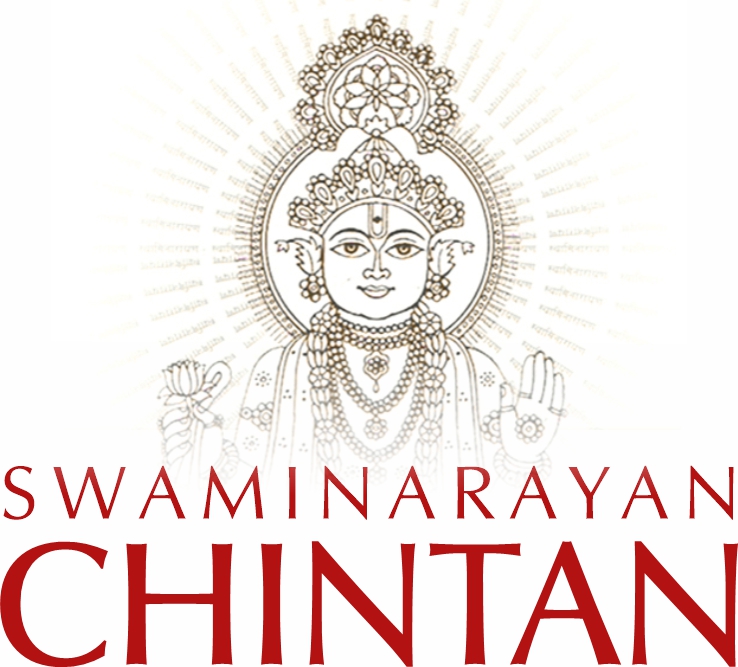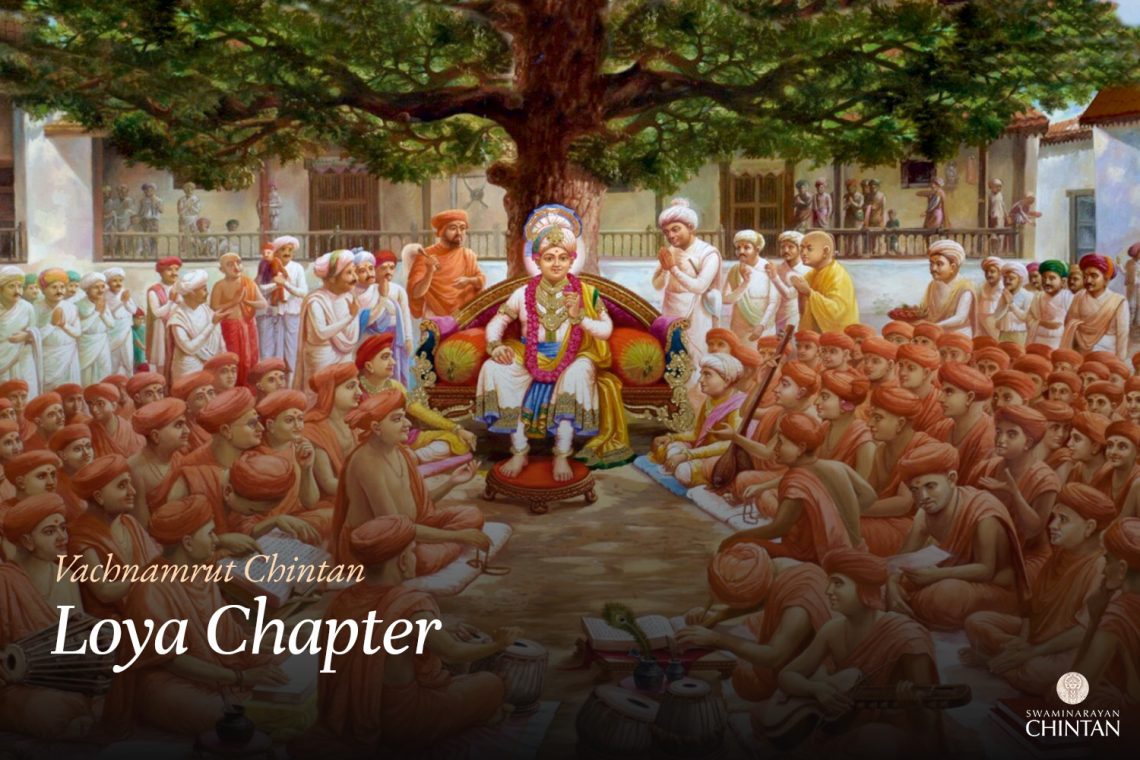Central Insights:
- The cause of the emergence of Dharma, Jnan, Vairagya, and Bhakti.
Main Points:
- Please refer to the explanation for details.
Commentary:
1. Characteristics:
धरति धारयति वाा लोकान् इति धर्मः ।
Dharma: Dharati dhārayati vā lokānīti dharmaḥ
(Dharma is that which upholds and supports all beings).
धर्मो ज्ञेयः सदाचारः श्रुतिस्मृत्युपपादित : ।
dharmo jñeyaḥ sadācāraḥ śruti-smṛty-upapāditaḥ |
(Dharma jāneyah (Dharma is known through good conduct)
as established by Shruti and Smriti
(Vedic texts and scriptures).
चोदना लक्षणो अर्थो धर्मः ।
codanā lakṣaṇo artho dharmaḥ |
(The purpose of Dharma is to guide behavior through commandments).
Vairagya:
वैराग्यम् ज्ञेयमप्रीतिः श्रीकृष्णेतरवस्तुषु ।
Vairāgyam jñeyam aprītih Śrīkṛṣṇetaravastuṣu
(Vairagya is known as detachment from anything other than Lord Krishna).
Gyan:
ज्ञानंं च जीवमाायेशरूपाणांं सुष्ठु वेदनम् ।
jñānaṁ ca jīva-māye-śarūpāṇāṁ suṣṭhu vedanam |
(Gyan is the proper understanding of the forms of Jeev, Maya, and Ishwar).
Bhakti:
माहात्म्यज्ञानयुग्भूरि स्नेहोःः भक्तिश्च माधवे ।
māhātmya-jñāna-yuktaḥ bhūrisnehaḥ bhaktiś ca mādhave |
(Bhakti is deep affection toward Madhav [God] combined with the knowledge of His greatness).
2. Essence (Swaroop or Form):
Dharma: Discipline and adherence to principles is the essence of Dharma.
Vairagya: Detachment from sensory objects is the essence of Vairagya.
Gyan: Correctly understanding an object as it truly is, is the essence of Gyan.
Bhakti: Affection toward one’s chosen deity is the essence of Bhakti, or complete surrender to one’s chosen deity is the manifested form of Bhakti.
3. Limits — The Ultimate Peak:
Dharma: The ultimate peak of Dharma is the attainment of Urdhvareta (the state of remaining celibate and pure), Nishkam (being desireless), or in yogic terms, the control of one’s vitality (Virya). Additionally, the full accomplishment of the five vows also marks its peak.
Vairagya: The ultimate peak of Vairagya is when the mind does not engage in any of the works of Prakruti (material nature) or Purush (the soul). When there is not even the slightest attachment to anything other than the feet of Bhagwan (God), that is the pinnacle of Vairagya.
Gyan: The ultimate peak of Jnan is to consider only Bhagwan as supreme and to not consider anything else as superior. This is the highest state of Jnan.
Bhakti: There is no defined limit to Bhakti. If one wishes to measure it, the Bhakti of the Gopis (devotees of Lord Krishna) can be considered the ultimate form of Bhakti.
4. Fruits:
Dharma: The fruit of Dharma is that one remains happy in the body and experiences happiness both in this life and the afterlife. Dharma also protects Jnan, Vairagya, and other virtues.
Vairagya: Even if sensory pleasures are attained, one does not become attached to them nor become lax. This is the fruit of Vairagya.
Gyan: The fruit of Jnan is not becoming entangled in bodily feelings. One is not ensnared by anything up to the level of Akshar (the eternal entity), and one develops deep affection for Bhagwan accompanied by an understanding of His greatness.
Bhakti: The fruit of Bhakti is that Bhagwan Himself becomes subservient to the devotee and is under the devotee’s control.
5. Causes of Emergence:
Dharma: The initial hearing of Shruti (Vedic texts) and Smriti (scriptures), which outline the rituals of Karma Kanda (ritualistic actions) and the instructions on what to do and what not to do, leads to the emergence of Dharma.
Vairagya: The true understanding of the nature of time, contemplation on dissolution (Pralaya), experiencing sudden shocks, undergoing suffering, and developing a vision that sees flaws in all material objects bring about the emergence of Vairagya.
Gyan: Hearing the teachings of Vedanta from a Srotriya (well-versed in scriptures) and Brahmanishta (established in Brahm) Sadguru (true guru), engaging in Satsang (spiritual company) with an attitude of faith, and understanding through time, as expressed in the Gita: तत्स्वयंं योगसंंसिद्धः कालेनात्मनि विन्दति — tatsvayam yogasam siddhaḥ kālenātmani vindati (Gita 4.38), lead to the emergence of Gyan.
Bhakti: Knowing the true nature of Bhagwan’s avatars, powers, and abodes, listening lovingly to the stories of the avatars, and hearing scriptures like the Bhagwat with faith and reflection, as well as witnessing miracles and divine occurrences with Astikbhav (faith in God), lead to the emergence of Bhakti.
6. Function:
Dharma: Dharma sustains, preserves, and ensures that nothing deteriorates.
Vairagya: Vairagya stops the mind from gravitating towards the material world.
Gyan: Jnan increases one’s eagerness to connect with Bhagwan.
Bhakti: Bhakti creates waves of joy and immerses the devotee in divine emotions, completely absorbing them in the feelings for Bhagwan.
7. Ideal Examples:
Dharma: Yudhishthir, Bhayatmanand Swami, Mayaram Bhatt.
Vairagya: Nishkulanand Swami, Adbhutanand Swami, Gunatitanand Swami, Jadbharat.
Gyan: Gopalanand Swami, Janak Maharaj, Shukdevji.
Bhakti: The Gopis, Premanand Swami, Sachchidanand Swami.
8. Limitations:
Dharma: Through Dharma, one cannot transcend beyond the abode of Brahma.
Vairagya: Vairagya makes one disinterested and indifferent not only to the world but also to Bhagwan and His devotees, if not practiced correctly.
Gyan: The strength gained from knowledge may lead to a certain laxity in practicing Dharma, although this may not be noticed.
Bhakti: Due to its strong emotional nature, Bhakti may quickly attach to worldly matters as well, making it a slippery path.
9.Other Characteristics:
Dharma: Dharma emphasizes faith and trust.
Vairagya: Vairagya emphasizes indifference and the insignificance of the world.
Gyan: Gyan emphasizes thought and discernment.
Bhakti: Bhakti emphasizes emotions and reverence for the greatness of Bhagwan.
10. Analogies and Comparisons:
Medicinal Analogies:
Dharma: Dharma is like a medicine that heals fractures.
Vairagya: Vairagya is like a medicinal herb that removes the poison.
Gyan: Gyan is like a medicine that heals wounds.
Bhakti: Bhakti is like the Sanjeevani herb that revives life.
Agricultural Analogies:
Dharma: Dharma is like the protective fence around a field.
Vairagya: Vairagya is like the weeding, hoeing, and other maintenance of the field.
Gyan: Gyan is like plowing the field.
Bhakti: Bhakti is like the sowing of seeds. Bhagwan is the resulting fruit.
Cooking Analogies:
Dharma: Dharma is like fire or heat.
Vairagya: Vairagya is like the flour.
Gyan: Gyan is like the clarified butter.
Bhakti: Bhakti is like dedication.
Ornament Analogies:
Dharma: Dharma is like the garment.
Vairagya: Vairagya is like the jewelry.
Gyan: Gyan is like the health of the body.
Bhakti: Bhakti is like the beauty of a woman in the form of devotion.
11. From the Perspective of Literary Emotion — Permanent Sentiments:
Dharma: Paropkarah (altruism). Since one takes joy in altruism, one worships Bhagwan through the medium of altruistic actions.
Vairagya: Tyagah (renunciation). One worships Bhagwan through renunciation, and as one continues on the path with renunciation in the heart, Vairagya becomes a part of one’s faith (Vairagya Nishtha).
Gyan: Tapah (austerity). One worships Paramatma through the medium of austerities, meaning by reducing indulgence in prescribed sensory pleasures.
Bhakti: Ragah (attachment). One worships Paramatma through the medium of attachment. Rag is inherently object- focused, and by gaining the object of desire, the longing is fulfilled. When the object of Rag becomes Bhagwan, the efforts undertaken toward this attachment are called Bhakti.
12. From a Spiritual Perspective:
Dharma: Dharma is the manifestation of Paramatma in actions.
Vairagya: Vairagya is the manifestation of Paramatma in detachment from sensory pleasures.
Gyan: Gyan is the manifestation of Paramatma in one’s intellect.
Bhakti: Bhakti is the manifestation of Ishwar in attachment.
13. Motivations:
Dharma: The root of the desire for happiness lies in Dharma.
Vairagya: From Vairagya arises the desire to relinquish (Jihasa).
Gyan: In Gyan, curiosity (Jijnasa) is paramount, and Gyan is nurtured by this curiosity.
Bhakti: In Bhakti, the thirst for love (Pipasa) is awakened, and through this, Bhakti is strengthened.
14. Expectations:
Dharma: Due to a flaw in his Dharma, Dharmaraj was born as the son of a servant, Vidur.
Vairagya: If other qualities are present but Vairagya is absent, one’s face becomes disfigured. For example, Naradji was cursed with the face of a monkey.
Gyan: Due to the absence of Gyan, one must endure hardships and obstacles. For instance, Sitaji spoke harsh words to Lakshman and suffered for it.
Bhakti: Without Bhakti, one does not attain peace. For example, Vyasa was restless despite his great knowledge.
Glossary
| Dharma – Righteousness The moral and ethical principles that uphold the universe, guiding individuals toward proper conduct. |
| Gyan – Knowledge The correct understanding of Jeev (soul), Maya (illusion), and Ishwar (God). |
| Vairagya – Detachment From Everything Except God |
| Bhakti – Devotion Loving and selfless worship of God. |
| Nishkam – Desirelessness A state where one performs actions without seeking personal rewards. |
| Urdhvareta – Celibacy The practice of preserving one’s spiritual energy by controlling physical desires. |
| Panch Vartman – The five sacred vows given by Bhagwan Swaminarayan |
| Prakruti – Material nature The fundamental nature of the physical world, which binds the soul to the cycle of birth and death. |
| Akshar – Eternal Entity The highest spiritual reality beyond material existence, often associated with Bhagwan’ Swaminarayans divine abode. |
| Vedanta – Conclusion of Vedas The ultimate philosophical teachings of the Vedas that describe the nature of God and liberation. |
| Shruti – Vedic texts The revealed scriptures that convey eternal knowledge, including the Vedas and Upanishads. |
| Smriti – Vedic Scriptures Texts derived from the wisdom of sages, including Dharma Shastras and epics like the Mahabharata and Ramayana. |
| Karma Kanda – Ritualistic actions The section of the Vedas that prescribes duties and rituals for material and spiritual prosperity. |
| Astikbhav – Faith in God The conviction in the existence and supremacy of Bhagwan. |
| Aniruddha – A form of Bhagwan One of the four Vyuh (manifestations) of Lord Vishnu, associated with control and sustenance. |
| Antaryami – Inner controller The omnipresent form of Bhagwan that resides within all living beings. |
| Moksh – Salvation The ultimate liberation of the soul from the cycle of birth and death and reaching divine abode of God |
| Tapah – Austerity Rigorous spiritual discipline undertaken to purify the mind and attain self-control. |
| Tyagah – Renunciation The practice of giving up material attachments to attain spiritual progress. |
| Paropkarah – Performing selfless actions for the benefit of others. |
| Ragah – Attachment A strong emotional bond, which, when directed towards Bhagwan, becomes the essence of Bhakti. |

